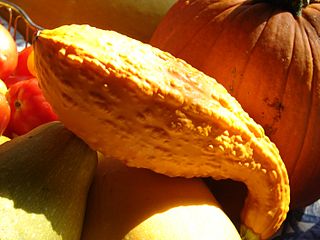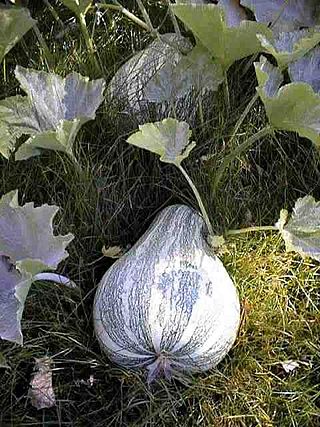
Cucurbita is a genus of herbaceous fruits in the gourd family, Cucurbitaceae, native to the Andes and Mesoamerica. Five edible species are grown and consumed for their flesh and seeds. They are variously known as squash, pumpkin, or gourd, depending on species, variety, and local parlance. Other kinds of gourd, also called bottle-gourds, are native to Africa and belong to the genus Lagenaria, which is in the same family and subfamily as Cucurbita, but in a different tribe. These other gourds are used as utensils or vessels, and their young fruits are eaten much like those of the Cucurbita species.

Cucurbita pepo is a cultivated plant of the genus Cucurbita. It yields varieties of winter squash and pumpkin, but the most widespread varieties belong to the subspecies Cucurbita pepo subsp. pepo, called summer squash.

Calabaza is the generic name in the Spanish language for any type of winter squash. Within an English-language context it specifically refers to what is also known as the West Indian pumpkin, a winter squash typically grown in the West Indies, tropical America, and the Philippines. Calabaza is the common name for Cucurbita moschata in Cuba, Florida, Puerto Rico, and the Philippines. C. moschata is also known as auyama in Colombia, the Dominican Republic and Venezuela; ayote in Mexico and Central America; zapallo in certain countries of South America; and "pumpkin", "squash", or "calabash" in English-speaking islands.

A pumpkin seed, also known in North America as a pepita, is the edible seed of a pumpkin or certain other cultivars of squash. The seeds are typically flat and asymmetrically oval, have a white outer husk, and are light green in color after the husk is removed. Some pumpkin cultivars are huskless, and are grown only for their edible seed. The seeds are nutrient- and calorie-rich, with an especially high content of fat, protein, dietary fiber, and numerous micronutrients. Pumpkin seed can refer either to the hulled kernel or unhulled whole seed, and most commonly refers to the roasted end product used as a snack.

Cucurbita ficifolia is a species of squash, grown for its edible seeds, fruit, and greens. It has common names including Asian pumpkin, black seed squash, chilacayote, cidra, fig-leaf gourd, and Malabar gourd. Compared to other domesticated species in its genus, investigators have noted that samples of C. ficifolia from throughout its range are relatively similar to one other in morphology and genetic composition. Variations do occur in fruit and seed color, some isozymes, and photoperiod sensitivity.

Butternut squash, known in Australia and New Zealand as butternut pumpkin or gramma, is a type of winter squash that grows on a vine. It has a sweet, nutty taste similar to that of a pumpkin. It has tan-yellow skin and orange fleshy pulp with a compartment of seeds in the blossom end. When ripe, it turns increasingly deep orange, and becomes sweeter and richer. It is a good source of fiber, vitamin C, magnesium, and potassium; and it is a source of vitamin A.

The Eastern Agricultural Complex in the woodlands of eastern North America was one of about 10 independent centers of plant domestication in the pre-historic world. Incipient agriculture dates back to about 5300 BCE. By about 1800 BCE the Native Americans of the woodlands were cultivating several species of food plants, thus beginning a transition from a hunter-gatherer economy to agriculture. After 200 BCE when maize from Mexico was introduced to the Eastern Woodlands, the Native Americans of the eastern United States and adjacent Canada slowly changed from growing local indigenous plants to a maize-based agricultural economy. The cultivation of local indigenous plants other than squash and sunflower declined and was eventually abandoned. The formerly domesticated plants returned to their wild forms.

Cucurbita moschata is a species originating in either Central America or northern South America. It includes cultivars known as squash or pumpkin. C. moschata cultivars are generally more tolerant of hot, humid weather than cultivars of C. maxima or C. pepo. They also generally display a greater resistance to disease and insects, especially to the squash vine borer. Commercially made pumpkin pie mix is most often made from varieties of C. moschata. The ancestral species of the genus Cucurbita were present in the Americas before the arrival of humans. Evolutionarily speaking the genus is relatively recent in origin as no species within the genus is genetically isolated from all the other species. C. moschata acts as the genetic bridge within the genus and is closest to the genus' progenitor.

Crookneck squash, also known as yellow squash, is a cultivar of Cucurbita pepo, the species that also includes some pumpkins and most other summer squashes. The plants are bushy and do not spread like the plants of winter squash and pumpkin. Most often used as a summer squash, it is characterized by its yellow skin and sweet yellow flesh, as well as its distinctive curved stem-end or "crooked neck". It should not be confused with crookneck cultivars of Cucurbita moschata, such as the winter squash 'Golden Cushaw', or the vining summer squash 'Tromboncino'. Its name distinguishes it from another similar-looking variety of C. pepo, the straightneck squash, which is also usually yellow. There is one similar non-edible C. pepo variety: C. pepo var. ovifera.

Delicata squash is a variety of winter squash with cream-coloured cylindrical fruits striped in green or orange that are cooked. As its name suggests, it has characteristically a delicate rind. It is also known as peanut squash, Bohemian squash, or sweet potato squash. It is a very sweet variety with a thin, edible skin and is typically cut into half rounds and roasted. It is a cultivar of the species Cucurbita pepo, which also includes the summer squash varieties pattypan squash, zucchini, and yellow crookneck squash, as well as winter squash varieties including acorn squash, spaghetti squash, and most pumpkins used as Jack-o-lanterns.

Cucurbita foetidissima is a tuberous xerophytic plant found in the central and southwestern United States and northern Mexico. It has numerous common names, including: buffalo gourd, calabazilla, chilicote, coyote gourd, fetid gourd, fetid wild pumpkin, Missouri gourd, prairie gourd, stinking gourd, wild gourd, and wild pumpkin. The type specimen was collected from Mexico by Alexander von Humboldt and Aimé Bonpland sometime before 1817. In Latin, foetidissima means ill smelling.

Gem squash is a variety of summer squash that may have been domesticated from two wild varieties; Cucurbita texana found in the southern and central United States and Cucurbita fraterna found in Mexico. The dark green spherical fruit, when fully ripe, is about the size of a tennis ball. The young fruit is often harvested before it is fully ripe when it has a more delicate texture flavor.

Cucurbita maxima, one of at least five species of cultivated squash, is one of the most diverse domesticated species. This species originated in South America from the wild subspecies Cucurbita maxima subsp. andreana over 4,000 years ago. Cucurbita maxima, known for modern varieties as Hubbard, Delicious, Marblehead, Boston Marrow, and Turks Turban, originated in northern Argentina near the Andes or in certain Andean valleys. Secondary centers of diversity include India, Bangladesh, Myanmar, and the southern Appalachians.

Cucurbita digitata is a species of flowering plant in the squash family known by the common names fingerleaf gourd and bitter squash. It is similar to Cucurbita californica, Cucurbita cordata, Cucurbita cylindrata, and Cucurbita palmata and all these species hybridize readily. These species form the only restricted xerophyte species group in the genus Cucurbita. Each member of this species group is native to the Southwestern United States and Northwestern Mexico where they are relatively uncommon. Each group member is found in hot, arid regions with low rainfall. They prefer soil that is loose, gravelly, and well-drained. C. digitata is native to northern Baja California at higher elevations, northern Sonora, Mexico, southern Arizona, and southwestern New Mexico. The juvenile leaves of C. cylindrata, C. cordata, C. digitata, and C. palmata show a high degree of similarity, but their mature leaves are visibly different, as are their root structures. C. palmata and C. digitata are sympatric, with C. palmata separating the ranges of C. digitata at the juncture of Baja California, California, and Arizona. C. digitata fruits are clear green mottle that turns yellow at maturity, striped, and round.

A pumpkin is a vernacular term for mature winter squash of species and varieties in the genus Cucurbita that has culinary and cultural significance but no agreed upon botanical or scientific meaning. The term pumpkin is sometimes used interchangeably with "squash" or "winter squash", and is commonly used for cultivars of Cucurbita argyrosperma, Cucurbita ficifolia, Cucurbita maxima, Cucurbita moschata, and Cucurbita pepo.

Cucurbita argyrosperma, also called the cushaw squash and silver-seed gourd, is a species of winter squash originally from the south of Mexico. This annual herbaceous plant is cultivated in the Americas for its nutritional value: its flowers, shoots, and fruits are all harvested, but it is cultivated most of all for its seeds, which are used for sauces. It was formerly known as Cucurbita mixta.

Cucurbita okeechobeensis, the Okeechobee gourd, is a species of gourd in the family Cucurbitaceae, native to Mexico and the United States. There are two subspecies; one is endemic to Florida, primarily in the region around Lake Okeechobee, the other to the State of Veracruz in eastern Mexico. Once abundant, it has state and federal listing as an endangered species. One of its peculiarities is the yellow corolla not so common in other Cucurbita species.

Cucurbita ecuadorensis is a species of squash, described in 1965 growing wild in Ecuador. Like most wild gourds and squashes, it is creeping vine and is often found climbing over other vegetation. It has been found only in the western provinces of Guayas and Manabí. There is evidence that it was domesticated in Ecuador around 10,000 years ago, likely for its seeds, but no direct records exist and it is no longer cultivated. It is resistant to many diseases of cultivated Cucurbita species, and has been used to breed resistance to several diseases into common squashes. For example, researchers at Cornell University used Cucurbita ecuadorensis to breed resistance to papaya ringspot virus, watermelon mosaic virus, and powdery mildew, into common Cucurbita maxima cultivars. Cucurbita ecuadorensis is listed on the IUCN Red List as vulnerable, and is found protected in the Machalilla National Park.
Cucurbita galeottii is a plant species of the genus Cucurbita. It is native to Oaxaca, Mexico. It has not been domesticated. There is very little known about this species. Nee reports that the species is a xerophyte and that Bailey only saw the species in photographs. It is only known from specimens that "lack roots, female flowers, fruits and seeds".
Cucurbita lundelliana is a mesophyte plant species of the genus Cucurbita. It is native to Mexico, Guatemala, and Belize. It has not been domesticated. It is found in the Yucatán region near sea level among limestone cliffs. In Guatemala it is found in Parque Nacional Yaxha Nakum Naranjo along Rio Ixtinto and near Laguna Julequito.
















